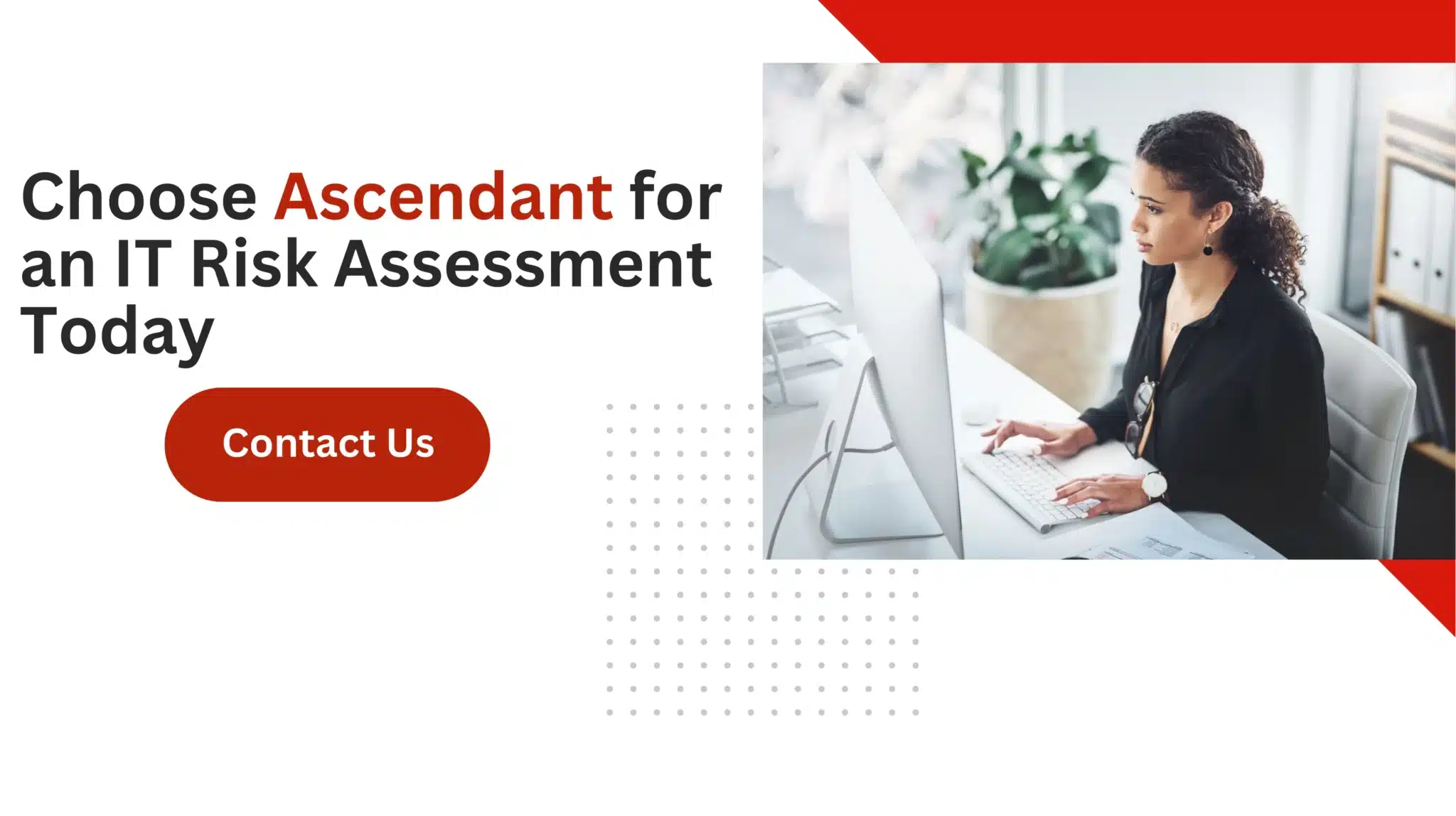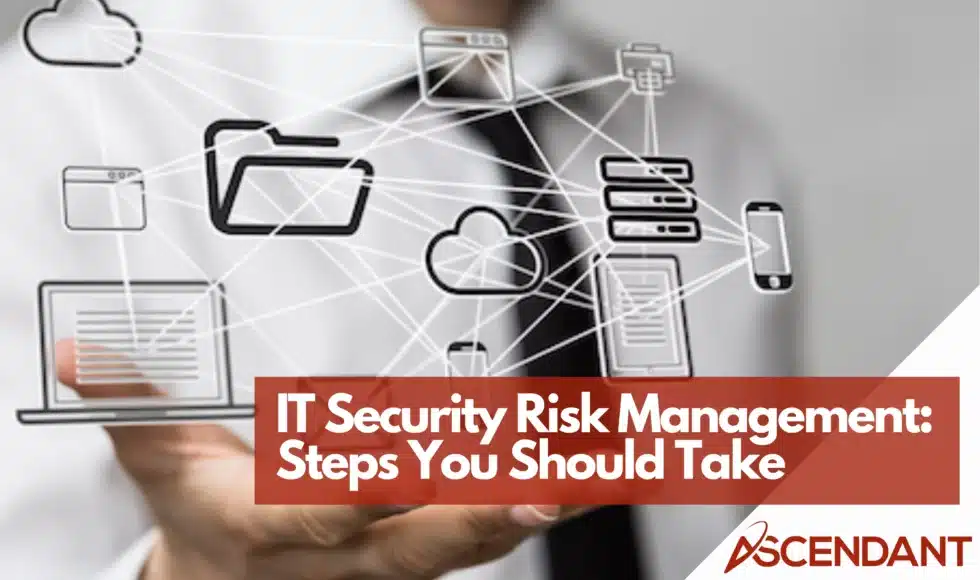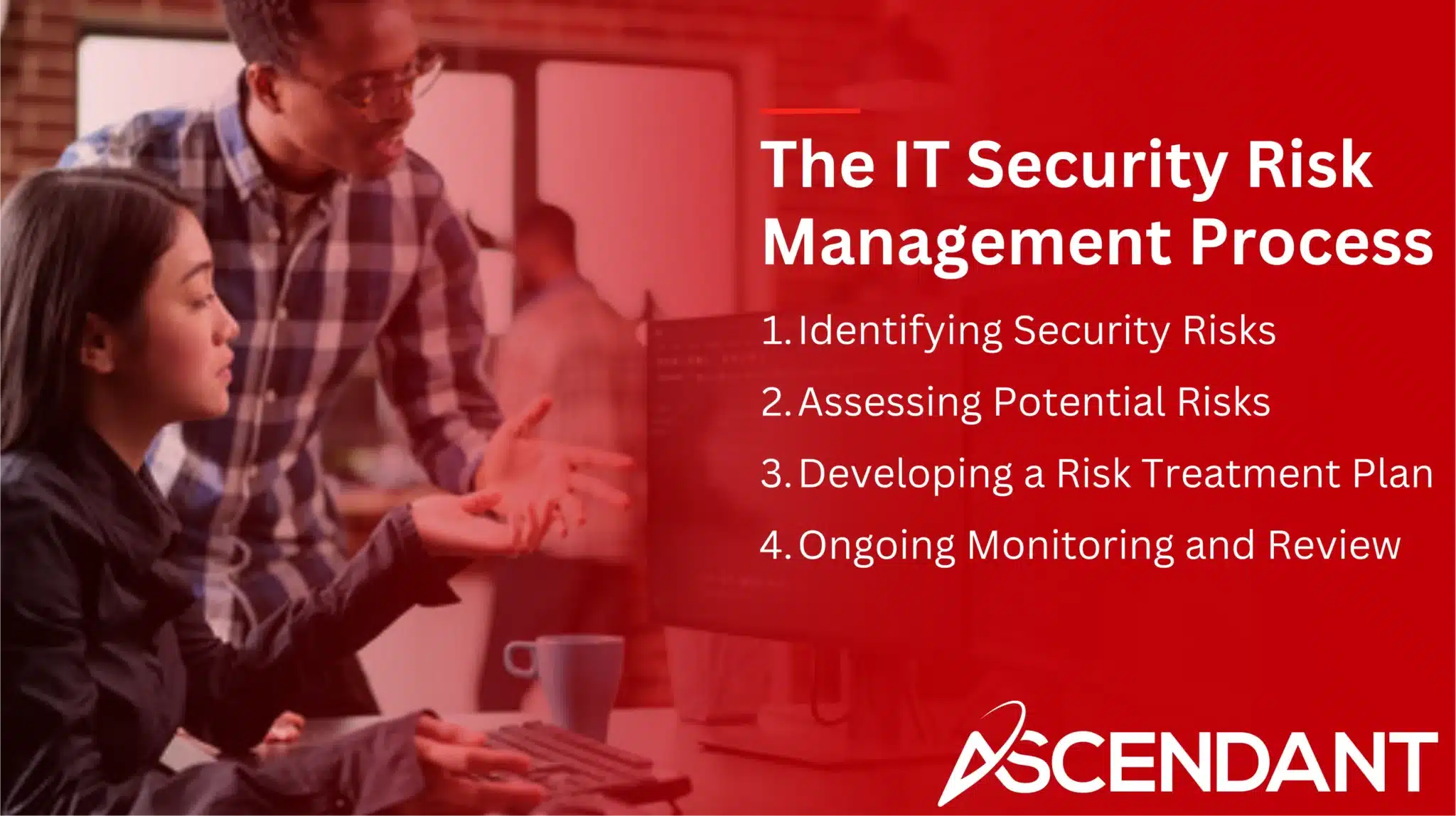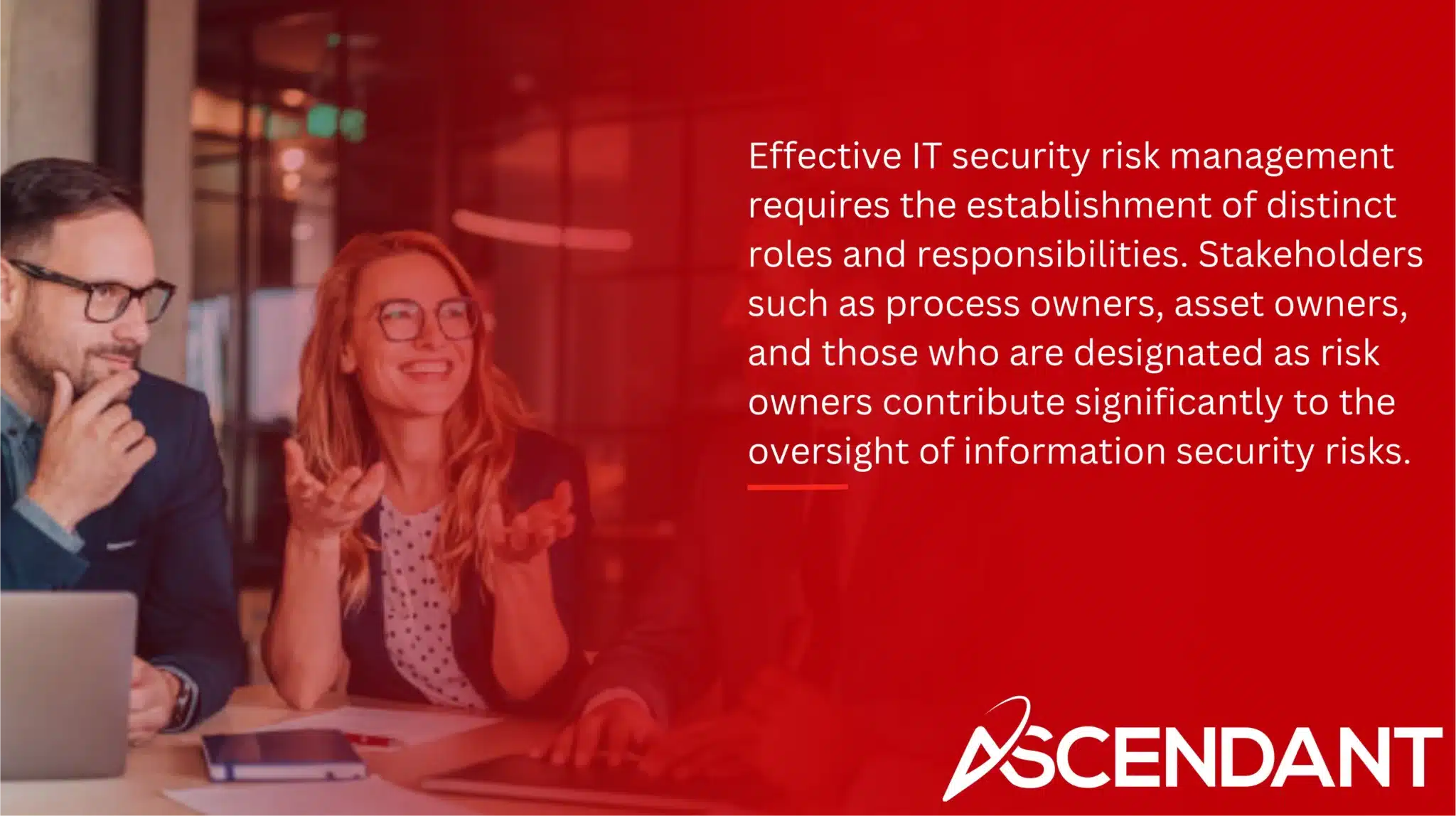IT security risk management is crucial for safeguarding an organization’s digital assets. With growing cyber threats, understanding and implementing effective risk management strategies can prevent major disruptions and financial losses. In this article, we will cover the key components, processes, frameworks, and best practices essential for robust cybersecurity.
Key Takeaways
- Effective IT security risk management relies on a disciplined process of identifying, assessing, treating, and continuously monitoring risks.
- Regular risk assessments prioritize vulnerabilities and enable organizations to allocate resources efficiently, improving overall cybersecurity posture.
- Implementing recognized frameworks, such as NIST and ISO/IEC 27001, enhances risk management efficiency and aligns security efforts with business objectives.
Understanding IT Security Risk Management
The cornerstone of a successful cybersecurity risk management strategy lies in IT security risk management, which is crucial for protecting an organization’s digital assets. This component aims to prevent threats that have the potential to interrupt business operations and lead to considerable economic damage. Effective cyber risk management is built on a structured, holistic approach that incorporates all aspects of security.
In response to modern complex cyber threats, it’s essential for organizations to employ a forward-looking and flexible strategy within their risk management practices.
Key Components of IT Security Risk Management
Effective security risk management in IT involves several crucial elements. Initially, the process begins with risk identification, which concentrates on detecting and ranking potential threats such as malware and data breaches. It also entails pinpointing valuable information resources, assessing possible dangers and susceptibilities. Lacking a robust approach to identify risks prevents organizations from crafting successful strategies for their mitigation.
Following this is the pivotal phase of risk assessment, wherein objectives are set along with criteria for evaluating risks within an established scope. This stage measures both how probable it is that certain risks will occur and their estimated effect on the organization. Utilizing automated tools to scan vulnerabilities provides an expansive view of organizational exposure to different hazards, guiding decisions regarding what level of risk can be tolerated.
Subsequent to evaluation comes devising tactics for managing identified security issues—choosing whether to reduce weaknesses technologically or through policy changes, offsetting them via insurance mechanisms or opting for deliberate acceptance when justified by impact analysis. Keeping track of these approaches continuously while reevaluating them guarantees they remain adequate amid changing security landscapes involving new challenges and threats.
The Role of Risk Assessments in IT Security
Conducting risk assessments is essential in IT security, as it enables organizations to identify and prioritize their vulnerabilities while adopting a proactive stance towards cyber threats. By assessing both the probability and consequences of potential risks, these evaluations inform the creation of robust threat management tactics. Identifying which threats are most dangerous aids in the strategic allocation of resources, enhancing cybersecurity defenses by way of information security risk assessments.
Routinely performed risk assessments help organizations stay ahead by adjusting to emerging threats and verifying that their defensive measures remain current. This forward-thinking approach reduces both the chance and severity of recognized dangers while promoting ongoing enhancement within an organization’s information security framework.
The IT Security Risk Management Process
The process of risk management in IT security is an ongoing loop that involves the identification, evaluation, mitigation, and tracking of risks to ensure the organization’s digital assets remain secure. Staying abreast of changing threats within enterprise risk management necessitates a dynamic cybersecurity risk management process which must be routinely assessed and refined.
Employing a systematic method allows organizations to uphold strong cyber defense mechanisms and effectively navigate their landscape of security risks.
Identifying Security Risks
The cornerstone of the risk management process is the identification of security risks, which encompasses threats like ransomware, phishing attacks, and data breaches that are now more frequent than ever. The advent of cloud services has added new layers to information security concerns by presenting distinctive challenges for companies as they oversee their digital resources across various platforms. When data is exchanged with external entities, it necessitates a meticulous analysis of potential threats and weak points in information security risk.
To carry out effective risk identification successfully means acknowledging these common hazards while scrutinizing their possible effects on an organization’s crucial systems. By pinpointing risks associated with informational assets and assessing potential exposures systematically, organizations can strategize where to focus attention efficiently, thus ensuring identified risks are addressed through proper allocation of protective measures and resource distribution.
Assessing Potential Risks
Evaluating the potential risks involves determining the probability of various threats and their possible consequences for the organization. This process is essential to identify which dangers are most significant and how they can be mitigated efficiently. The probability indicates how likely a risk is to occur, and the impact measures what could happen if it materializes.
In this phase, automated tools that scan for vulnerabilities prove extremely useful by offering in-depth views into an organization’s vulnerability environment. By conducting comprehensive risk analyses, organizations are able to make well-informed choices and strengthen their defenses against cyber-attacks.
Developing a Risk Treatment Plan
After pinpointing and evaluating potential risks, companies are tasked with devising a strategic risk treatment plan. This strategy encompasses the adoption of suitable options including minimizing risks, transferring them to another party, or altogether avoiding them. As an example, adopting technological safeguards such as encryption and firewalls is essential in mitigating known vulnerabilities. Revising policies might be imperative to maintain adherence to regulations and bolster security across the board.
It is critical for organizations to reflect upon their tolerance for risk as well as their available resources while executing a risk treatment plan. By confronting weaknesses head-on and fortifying security measures at all levels of operation, businesses can substantially lower the chances of facing adverse events related to cyber threats—thereby safeguarding their valuable digital properties.
Ongoing Monitoring and Review
Ongoing monitoring and review are essential components of the IT security risk management process. Continuous monitoring keeps internal controls effective against ever-changing threats. This process involves regularly assessing whether risk prevention or mitigation strategies are successful and making necessary adjustments.
Effective team communication is crucial for successful risk assessment and mitigation. Collaboration and the use of risk communication tools enhance the quality of assessments and the implementation of risk controls.
Implementing an IT Security Risk Management Framework
Establishing a structured framework for IT security risk management is essential to create an effective program that manages risks with minimal interruption. An organized and clearly defined risk management system improves the efficiency of an organization’s risk management efforts and safeguards its digital assets through continual evaluation and reaction.
Popular Frameworks and Standards
Widely acknowledged for its utility in managing security risks associated with information privacy, the NIST Risk Management Framework is a comprehensive guide that outlines a seven-step process. This versatile framework can be integrated into both new and existing systems across varied technological platforms and organizations of any type. The implementation of automation within this framework has shown to significantly improve the efficiency and rapidity with which these steps are carried out.
To the NIST Risk Management Framework, frameworks such as ISO/IEC 27001 exist, offering organized methods for handling IT security risks. These risk management frameworks aid in developing thorough risk management strategies that adhere to recognized industry standards and best practices, reinforcing an organization’s overall approach to risk mitigation.
Aligning with Organizational Goals
Selecting an appropriate IT security risk management framework is essential to align security measures with business goals. Organizations must adopt a framework like NIST or ISO/IEC 27001 that fits their overall risk management strategy. Proper alignment bolsters operational efficiency and guarantees that the implemented security measures aid in achieving the organization’s objectives.
Embedding a well-structured framework into an organization’s risk management approach enhances its capacity for effective risk control and safeguarding of digital assets.
Roles and Responsibilities in IT Security Risk Management
Effective IT security risk management requires the establishment of distinct roles and responsibilities. Stakeholders such as process owners, asset owners, and those who are designated as risk owners contribute significantly to the oversight of information security risks.
The triumph of a risk management strategy is grounded in a cohesive and synergistic effort among all parties involved.
Process Owners and Risk Owners
The individuals in charge of risk ownership bear the responsibility for mapping out and keeping a vigilant eye on potential risks within the scope of risk management. Their significant role is critical in guaranteeing that risks are proficiently managed and mitigated across the enterprise.
Those who own processes carry the duty to put security measures into action and preserve their ongoing effectiveness. Through their continuous dedication, these controls stay effective and congruent with the organization’s strategy for managing risks.
Collaboration between process owners and risk owners is essential to construct a solid framework dedicated to governing IT security threats. This partnership plays an integral part in confronting vulnerabilities and boosting the organization’s collective defenses against security concerns.
Collaboration Across Teams
Enhanced collaboration between information technology (IT) and security personnel greatly improves the organization’s ability to handle risks and react promptly to incidents. Joint training initiatives and consistent cross-functional gatherings promote improved dialogue and mutual comprehension among these teams. By setting collective aims, IT and security units are motivated to pursue shared targets, which boosts operational efficiency.
By creating straightforward communication pathways and utilizing unified security platforms, both departments can share critical threat-related information swiftly. This cooperative method ensures that the entity is consistently equipped to manage security threats with efficacy.
Benefits of Effective IT Security Risk Management
Implementing strong security risk management strategies provides several advantages such as improved data security, better operational efficiency, and heightened customer confidence. Through robust risk management in IT, companies are able to safeguard their digital resources, ensure the continuity of business operations, and promote a risk-conscious culture that enables staff members to effectively counteract potential threats.
Enhanced Data Security and Privacy
It is imperative for organizations to employ comprehensive risk management strategies to defend sensitive data against potential risks and vulnerabilities. By pinpointing and mitigating these weaknesses, entities can establish strong security measures like access restrictions and encryption. Audits focused on cybersecurity play a pivotal role in maintaining compliance and pinpointing frailties within digital frameworks.
The adoption of such practices serves the twofold purpose of securing critical information while simultaneously fulfilling legal requirements related to regulations. In doing so, an organization bolsters its overall security stance while adhering to its statutory responsibilities.
Improved Operational Efficiency
Security protocols must be designed in such a way that they enhance user experience and operational efficiency, while maintaining robust protection for IT systems. Ensuring these security measures are woven into the users’ workflows with minimal disruption is crucial to guarantee that safeguarding efforts do not hinder performance or become cumbersome.
Building Customer Trust
An effective risk management strategy can substantially improve an organization’s standing by reducing the likelihood of security incidents. By showing a dedication to safeguarding through competent risk management, an organization can increase customer trust and loyalty since customers are reassured about the protection of their personal information.
Best Practices for IT Security Risk Management
Adopting top-notch procedures in IT security risk management not only makes processes more efficient, but also bolsters overall operational performance. Organizations that engage in these practices are better equipped to manage potential threats proactively and strengthen their cybersecurity defenses.
Regular Security Audits and Assessments
Conducting frequent security assessments is crucial for pinpointing weaknesses and immediately revising security protocols. Such audits must be a core component of any cybersecurity management plan to guarantee robust protection measures are in place, as well as adherence to legal and regulatory obligations.
The adoption of automated systems can sustain the integrity of security while minimizing the imposition of laborious manual operations on users. Through these routine checks, entities have the advantage of preemptively countering possible hazards and perpetually enhancing their defensive stance against threats.
Employee Training and Awareness Programs
Adopting robust security protocols and engaging in comprehensive employee training initiatives can markedly diminish the potential for data breaches and cyber threats. By leveraging various instructional techniques, including interactive webinars and practice simulations, companies can improve the impact of cybersecurity knowledge among staff members while maintaining their engagement.
Cultivating an atmosphere where risk consciousness is prevalent enables team members to identify and act upon possible dangers with greater efficiency. Such a forward-looking stance strengthens the entity’s defensive measures against unauthorized access or attacks, thereby reinforcing its risk management strategy as part of broader organizational risk management efforts.
Integrating Cybersecurity with Business Continuity Planning
Integrating cybersecurity protocols with strategies for business continuity is crucial to enable an organization’s recovery from disruptive incidents. By incorporating a robust cybersecurity strategy into the framework, the adverse effects on business operations can be minimized and the overall resilience of the organization can be strengthened.
By synchronizing efforts between cybersecurity and business continuity planning, organizations are able to respond more effectively and in a united manner when facing incidents. Such alignment helps safeguard digital assets while also ensuring that there is minimal interruption to ongoing business operations.
Common Challenges in IT Security Risk Management
The increasing threat of cyberattacks and data breaches presents significant challenges for organizations. Managing these risks requires a proactive approach and the ability to adapt to rapidly evolving threats. Organizations must address these challenges to protect their digital assets effectively from a data breach.
Balancing Security and Usability
In the realm of IT security risk management, striking a balance between safety and practicality presents a notable challenge. Security measures that are too restrictive can impede user efficiency and result in weak adherence to protocols. By incorporating adaptive authentication methods, it becomes possible for security intensities to be modulated based on the context of usage—this achieves minimal disruption to users while still upholding adequate defense mechanisms. Engaging users in devising policies may yield regulations that successfully accommodate both demands for robust security standards as well as user effectiveness.
The integration of Multi-factor Authentication (MFA) alongside Single Sign-On (SSO) strategies enhances protection levels yet does so without drastically affecting the end-user experience. Consistently reassessing and refining these established security protocols ensures resilience against emerging threats whilst preserving ease-of-use.
Adopting an approach composed of multiple layers when formulating protective strategies implements diverse safeguards, which collectively do not overburden users with unnecessary limitations.
Keeping Up with Evolving Threats
As technology swiftly advances and new security threats materialize, IT security management faces ongoing hurdles. To safeguard their digital resources with efficacy, institutions must stay alert and flexible. The burgeoning use of cloud services and the intricacies introduced by external data exchange add layers of complexity to managing IT security, necessitating a perpetual reevaluation and refinement of organizations’ approach to cybersecurity.
To combat the progression of these threats, it’s essential for entities to focus on consistent learning opportunities and enhancement programs for their cybersecurity personnel. Keeping abreast with current threat landscapes, recognizing system vulnerabilities, and understanding cutting-edge protective technologies are crucial steps in this process. Regular enhancements to protocols as well as updating existing security measures bolster an organization’s defenses against both extant dangers as well as those just appearing on the horizon.
Summary
In conclusion, IT security risk management is a multifaceted process that requires a proactive and adaptive approach. By understanding the key components of risk management, implementing a structured framework, and fostering collaboration across teams, organizations can effectively protect their digital assets from evolving threats. Regular risk assessments, robust risk treatment plans, and ongoing monitoring are essential for maintaining a strong security posture.
Effective IT security risk management not only enhances data security and operational efficiency, but also builds customer trust and loyalty. By following best practices and addressing common challenges, organizations can navigate the complexities of cybersecurity and ensure their long-term resilience. Stay vigilant, stay informed, and remember that a proactive approach to risk management is your best defense against cyber threats.
 Frequently Asked Questions
Frequently Asked Questions
What are the key components of IT security risk management?
The key components of IT security risk management are risk identification, risk assessment, risk treatment, and ongoing monitoring and review, ensuring a comprehensive approach to managing security risks.
How can risk assessments improve IT security?
By identifying and ranking vulnerabilities through risk assessments, organizations can strengthen their IT security by proactively handling and lessening the likelihood of cyber threats.
Concentrating on risk evaluation results in more robust security measures and diminishes the severity of any incidents that may occur.
Why is ongoing monitoring important in IT security risk management?
Ongoing monitoring is crucial in IT security risk management as it ensures internal controls adapt to evolving threats, necessitating regular assessments to maintain their effectiveness.
This proactive approach helps protect organizational assets and data.
What are some popular frameworks for IT security risk management?
Popular frameworks for IT security risk management include the NIST Risk Management Framework and ISO/IEC 27001, both of which offer robust and structured methodologies for addressing information security risks.
How does effective IT security risk management benefit an organization?
Effective IT security risk management significantly enhances data security and privacy while also improving operational efficiency and building customer trust.
By mitigating the likelihood and impact of data breaches, organizations can operate with greater confidence and integrity.



